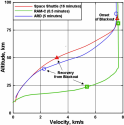Let's give it a try with a back of the envelope calculation.
1. Last guidance in space before plasma sheath appears during reentry
Let's say this starts at 80km, as per the Space Shuttle
A Mach 7 MaRV takes 41seconds to impact
In that time, a carrier travelling at 30knots (55km/h) travels 626m.
But in 41 seconds at full speed, how much can a carrier turn direction? An 8KM turning circle has been mentioned, which is 523seconds.
A carrier travelling at slower speeds can turn faster, but won't travel as far.
That narrows the target area further.
That gets a Mach 7 MaRV close to a carrier, possibly good enough for a wide dispersion cluster warhead to score hits.
I reckon this is a backup mode, if the MaRV can't obtain terminal guidance.
Otherwise the MaRV would go for a tighter dispersion of cluster munitions with terminal guidance.
So there is the armour piercing MaRV body, plus cluster munitions.
2. Terminal Guidance
A Mach 7 MaRV will cover the last 10km in 5 seconds before impacting.
In that time, a carrier could travel 152m, but again the target area is smaller than this because the carrier can't change direction in only 5 seconds.
And an aircraft carrier has a deck width of 76m.
A Peacekeeper warhead has a CEP of 40m, presumably from its attitude control jets and internal inertial guidance.
The Mach 7 Iskander MaRV is supposed to have a 5m-30m CEP with its terminal guidance.
Plus we also see Air-to-Air missiles with attitude control jets for terminal manoeuvres against manoeuvring fighter jets.
2A. Remote Terminal Guidance
Also remember that the space shuttle could communicate with satellites during reentry, because the plasma shroud didn't cover the back of the aircraft.
And we've seen technical diagrams with antenna protruding from the back of a MaRV beyond the plasma shroud.
So theoretically a MaRV could be remotely guided by external sensors to the target point.
2B. Local Terminal Guidance
But external sensors and comms can be jammed or destroyed.
Plus there is the feedback loop and communications lag
So the MaRV should also has its own radar seeker for terminal guidance.
That seeker only has to look at a small target box, and the attitude control jets should be sufficient to adjust the final aimpoint
Some comments to the numbers according to my reading of a research paper "
Plasma-Radiofrequency Interactions Around Atmospheric Re-Entry Vehicles:Modelling and Arc-Jet Simulation by Raffaele Savino of University of Naples Federico II", see the diagram below.
The onset of blackout is 80km as you said. But the velocity at that time is
Mach 20 (7km/s +). The
recovery (exit) altitude is 40km for ESA ADM capsule or 50km for Shuttle, the volocity is 2 and 3 km/s, roughly mach 6 to 9. So
time to impact is much shorter than 41s. This means the target has a even shorter time to evade,
let's say 30s (from onset to impact).
However we should remember that both a space shuttle and space capsule are shaped to slow down, so their recovery velocity is lowered to mach 6/9. Iskander is a SRBM, so the mach 7. DF-1D would be similar to Iskandar, so Mach 7 being reasonable.
DF-26 is IRBM, the warhead is long and pointy, so expect
much higher recovery velocity (say Mach 15). This is demonstrated by RAM-C test vehicle at Mach 16. So facing at DF-26, it is probably 10 to 20s.
As of the terminal guidance, it is known that DF-21D and DF-26 use onboard radar guidance (local) at least. There is a 2011 national reward to a person who developed
heat ablation radar dome. That reward was published on official web site but quickly removed.
As of the remote terminal guidance, it is not certain but possible as I said in earlier post. And if that technique is implemented, there would be no blackout at all.





